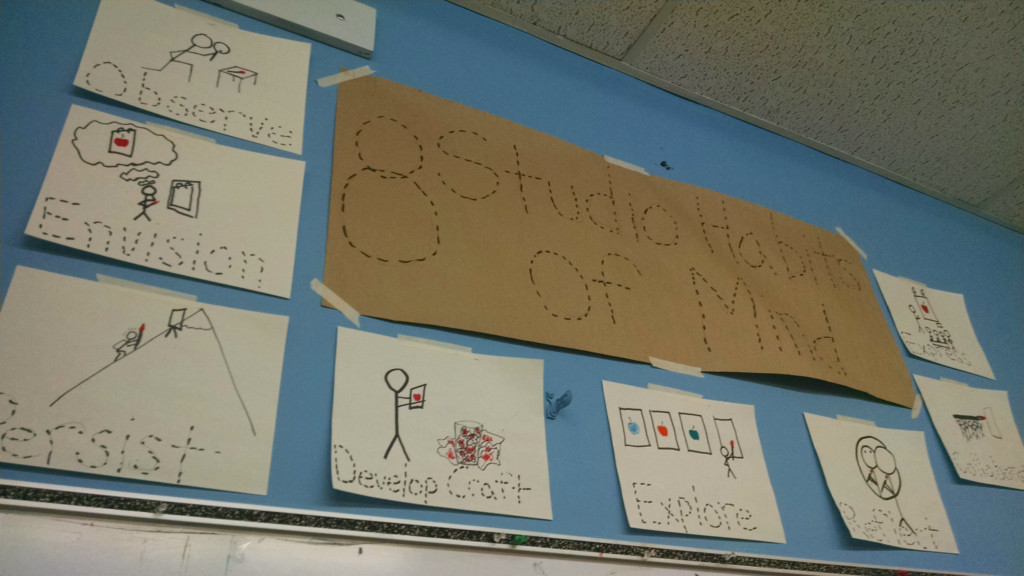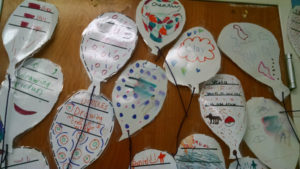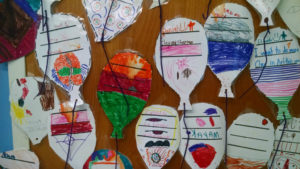Welcome to the Art blog! I’m so happy to share the amazing work that children have been doing this year as they grow into budding young artists. The art curriculum I am following will hopefully lead to both quality work and informative processes that are the hallmarks of effective art education. To begin, let me introduce you to the 8 Studio Habits of Mind. 
A team of Harvard University researchers and educators set out to analyze and synthesize a list of habits that successful artists develop. The result was the 8 Studio Habits of Mind. In no particular order, they found that successful artists: Observe, Envision, Persist, Develop Craft, Explore, Reflect, Collaborate and Present. Over the year, instead of having units developed around famous artists, or art work, or materials and techniques, students will be asked to exemplify these traits of real artists throughout the year. This provides some structure and unity to choice-based art.
But what is choice-based art? It looks like this:
Instead of being handed a template and having all students work on the same project, students are given free reign to explore the available materials that they feel best suited to accomplish their goals. Although I rarely give whole-class instruction in art, there is a still a role for the teacher in choice-based art. Every day, in addition to children’s free choice, there is a teacher-led option where students can join me in a small scaffolded group project.
A big feature of choice-based art is empowering children to take ownership over both the process and the space. Everything written in dotted lines, from signage to labels, is an invitation for children to “connect the dots” (i.e. take down my boring, adult sign and make your own.) There are two large spaces dedicated to showing students work. One is an “Inspiration Station:”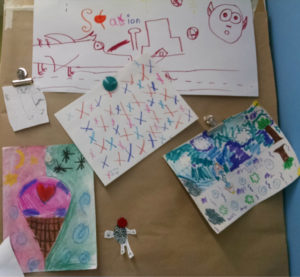
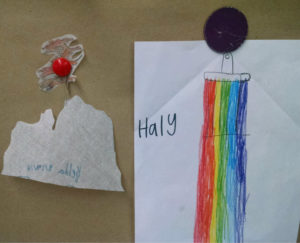
This is an informal, student-curated space where children are free to put up or take down anything they make (as long as there is a free magnet). Students can only use this space for a month and work will be regularly cycled through. This is right above a small library of books on artists, techniques, and beautifully illustrated children’s books. The aim is to allow students who are overwhelmed with a choice-based curriculum to find inspiration on their own without being spoon fed.
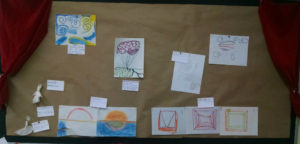 The other display area is the “Featured Artists Boards” which is by invite only. Students are asked to display their work on the Featured Artists Board only if I think that they exemplified the Habit of Mind that we are focusing on for that week. Here a few examples:
The other display area is the “Featured Artists Boards” which is by invite only. Students are asked to display their work on the Featured Artists Board only if I think that they exemplified the Habit of Mind that we are focusing on for that week. Here a few examples:
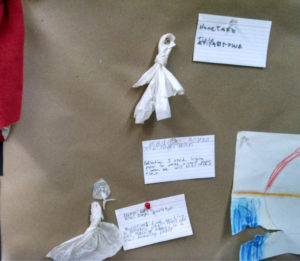 The artist who made the figure above was learning about making life size paper puppets in Jewish Studies. While tape was not yet a material we were using in class, he experimented with many different types of paper until he stumbled upon the pad of tracing paper in the inspiration station. He found it was pliable enough to be shaped but resistant enough to hold the shape. Without using any tape, he formed the figure above, beaming as he showed it to me. I reminded him how limitations spark creativity, and that if he had just used tape he would have never made the discovery. The next class, another student was impressed with his work and tried to make his own figure. This time, the students used tissue paper, but still developed craft to make it without using any tape.
The artist who made the figure above was learning about making life size paper puppets in Jewish Studies. While tape was not yet a material we were using in class, he experimented with many different types of paper until he stumbled upon the pad of tracing paper in the inspiration station. He found it was pliable enough to be shaped but resistant enough to hold the shape. Without using any tape, he formed the figure above, beaming as he showed it to me. I reminded him how limitations spark creativity, and that if he had just used tape he would have never made the discovery. The next class, another student was impressed with his work and tried to make his own figure. This time, the students used tissue paper, but still developed craft to make it without using any tape.
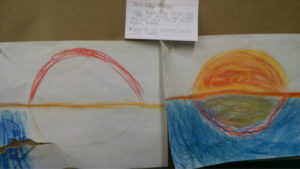 One student, exploring pastels, tried to use a wet tissue to blend colors. When she accidentally ripped her paper she was not discouraged but tried again, using her hard won knowledge to create a successful composition.
One student, exploring pastels, tried to use a wet tissue to blend colors. When she accidentally ripped her paper she was not discouraged but tried again, using her hard won knowledge to create a successful composition.
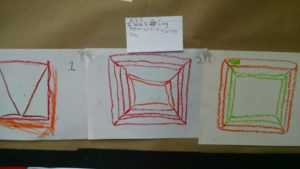 Another student, inspired by an example I had shown the class, was trying to portray 3-d depth using 2-d lines. You can see a clear progression from the first draft (far left) to the third (far right) as the student persisted in exploring and experimenting in order to work towards mastering a difficult technique. If I had merely taught him how to do it, the lesson would not be as lasting or meaningful. Portraying all three drafts on the board is also showcasing the fact that artists must be brave, make mistakes, and then learn from them.
Another student, inspired by an example I had shown the class, was trying to portray 3-d depth using 2-d lines. You can see a clear progression from the first draft (far left) to the third (far right) as the student persisted in exploring and experimenting in order to work towards mastering a difficult technique. If I had merely taught him how to do it, the lesson would not be as lasting or meaningful. Portraying all three drafts on the board is also showcasing the fact that artists must be brave, make mistakes, and then learn from them.
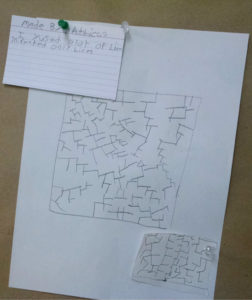 Lastly, there was a student who was only interested in solving a maze book in the inspiration station. He asked if he could “just do mazes” and I told him, “yes, of course, but for every five mazes you solve you have to make on original one.” He said he couldn’t and he didn’t know how, and then ten minutes later showed me the maze above.
Lastly, there was a student who was only interested in solving a maze book in the inspiration station. He asked if he could “just do mazes” and I told him, “yes, of course, but for every five mazes you solve you have to make on original one.” He said he couldn’t and he didn’t know how, and then ten minutes later showed me the maze above.
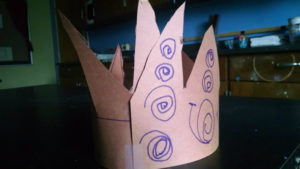 For younger students, choice-based art looks slightly different, and Kindergarten and Pre-K students do more scaffolded projects that are usually based on books we read at the beginning of the class. One project, based on What Do You Do With an Idea? by Kobi Yamada, was to make a crown. Here again, although many kids used and followed my template for a crown (i.e. yellow paper, spikey crown), others challenged themselves in novel ways. The student’s crown on the right was the result of two weeks of focused, determined work, and did much to advance the student’s growth in fine motor control, grit, and execution.
For younger students, choice-based art looks slightly different, and Kindergarten and Pre-K students do more scaffolded projects that are usually based on books we read at the beginning of the class. One project, based on What Do You Do With an Idea? by Kobi Yamada, was to make a crown. Here again, although many kids used and followed my template for a crown (i.e. yellow paper, spikey crown), others challenged themselves in novel ways. The student’s crown on the right was the result of two weeks of focused, determined work, and did much to advance the student’s growth in fine motor control, grit, and execution.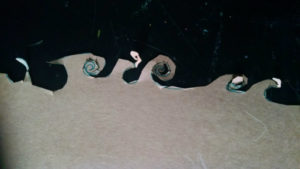
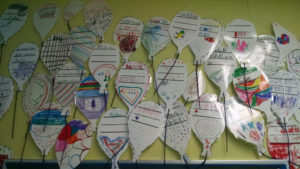
Students are asked to reflect daily on their work and how it exemplified the studio habit of mind we are focusing on. They ultimately are accountable to themselves both in the classroom and beyond. To this end, the one project that was completely teacher led and everyone had to complete is shown below. Each student was asked to decorate a balloon and write a goal they had for art this year. As a project, I’m glad that students took it seriously and produced beautiful work; as a visual metaphor, I can think of nothing more appropriate than having the students own self-created goals keeping them aloft, inspiring them to push to greater and greater heights of artistry.
Stay tuned for an update about how students “Developed Craft” during September and October. Thanks for reading!
Mr. Mirsky.
